NumPy中where和argwhere函数的详细对比与应用
NumPy是Python中用于科学计算的核心库,它提供了许多强大的函数来处理多维数组。其中,where和argwhere是两个常用的函数,用于在数组中查找满足特定条件的元素。虽然这两个函数看起来相似,但它们的功能和返回结果有着显著的区别。本文将深入探讨where和argwhere函数的特点、用法以及它们之间的区别,帮助读者更好地理解和应用这两个函数。
1. NumPy where函数
1.1 where函数的基本概念
numpy.where函数是NumPy库中的一个非常有用的函数,它可以根据给定的条件返回满足条件的元素的索引或者根据条件选择不同的值。这个函数的灵活性使得它在数据处理和分析中有着广泛的应用。
where函数的基本语法如下:
numpy.where(condition[, x, y])
condition:一个布尔数组或者可以被转换为布尔数组的表达式。x:当条件为True时返回的值(可选)。y:当条件为False时返回的值(可选)。
1.2 where函数的基本用法
让我们通过一些简单的例子来了解where函数的基本用法:
import numpy as np
# 创建一个示例数组
arr = np.array([1, 2, 3, 4, 5, 6, 7, 8, 9, 10])
# 使用where函数找出大于5的元素的索引
result = np.where(arr > 5)
print("numpyarray.com - Indices of elements greater than 5:")
print(result)
Output:

在这个例子中,我们创建了一个包含1到10的数组,然后使用where函数找出所有大于5的元素的索引。where函数返回一个元组,其中包含满足条件的元素的索引。
1.3 where函数的条件选择
where函数还可以根据条件选择不同的值。这在数据处理中非常有用,可以根据某些条件快速替换或修改数组中的值。
import numpy as np
# 创建一个示例数组
arr = np.array([1, 2, 3, 4, 5, 6, 7, 8, 9, 10])
# 使用where函数根据条件选择值
result = np.where(arr > 5, arr * 2, arr)
print("numpyarray.com - Array after conditional selection:")
print(result)
Output:

在这个例子中,我们使用where函数来创建一个新数组。对于原数组中大于5的元素,我们将其值翻倍;对于小于或等于5的元素,我们保持原值不变。
1.4 where函数处理多维数组
where函数不仅可以处理一维数组,还可以处理多维数组。这在处理图像数据或其他复杂的数据结构时非常有用。
import numpy as np
# 创建一个2D示例数组
arr_2d = np.array([[1, 2, 3], [4, 5, 6], [7, 8, 9]])
# 使用where函数找出大于5的元素的索引
result = np.where(arr_2d > 5)
print("numpyarray.com - Indices of elements greater than 5 in 2D array:")
print(result)
Output:

在这个例子中,我们创建了一个3×3的二维数组,然后使用where函数找出所有大于5的元素的索引。返回的结果是一个包含两个数组的元组,分别表示满足条件的元素的行索引和列索引。
1.5 where函数的高级应用
where函数还可以与其他NumPy函数结合使用,实现更复杂的操作。例如,我们可以结合where和logical_and函数来查找满足多个条件的元素:
import numpy as np
# 创建一个示例数组
arr = np.array([1, 2, 3, 4, 5, 6, 7, 8, 9, 10])
# 使用where函数找出大于3且小于8的元素的索引
result = np.where(np.logical_and(arr > 3, arr < 8))
print("numpyarray.com - Indices of elements between 3 and 8:")
print(result)
Output:

在这个例子中,我们使用logical_and函数来组合两个条件,找出数组中大于3且小于8的元素的索引。
2. NumPy argwhere函数
2.1 argwhere函数的基本概念
numpy.argwhere函数是另一个用于查找满足条件的元素的函数。与where函数不同,argwhere函数直接返回满足条件的元素的坐标,而不是索引。
argwhere函数的基本语法如下:
numpy.argwhere(condition)
condition:一个布尔数组或者可以被转换为布尔数组的表达式。
2.2 argwhere函数的基本用法
让我们通过一个简单的例子来了解argwhere函数的基本用法:
import numpy as np
# 创建一个示例数组
arr = np.array([1, 2, 3, 4, 5, 6, 7, 8, 9, 10])
# 使用argwhere函数找出大于5的元素的坐标
result = np.argwhere(arr > 5)
print("numpyarray.com - Coordinates of elements greater than 5:")
print(result)
Output:
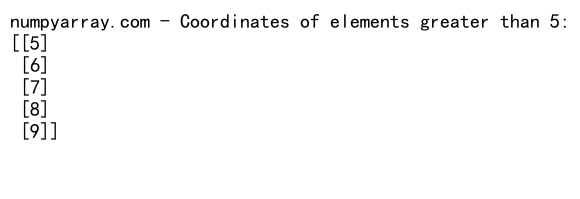
在这个例子中,我们创建了一个包含1到10的数组,然后使用argwhere函数找出所有大于5的元素的坐标。argwhere函数返回一个二维数组,其中每一行表示一个满足条件的元素的坐标。
2.3 argwhere函数处理多维数组
argwhere函数同样可以处理多维数组,并返回满足条件的元素的完整坐标:
import numpy as np
# 创建一个2D示例数组
arr_2d = np.array([[1, 2, 3], [4, 5, 6], [7, 8, 9]])
# 使用argwhere函数找出大于5的元素的坐标
result = np.argwhere(arr_2d > 5)
print("numpyarray.com - Coordinates of elements greater than 5 in 2D array:")
print(result)
Output:

在这个例子中,我们创建了一个3×3的二维数组,然后使用argwhere函数找出所有大于5的元素的坐标。返回的结果是一个二维数组,其中每一行表示一个满足条件的元素的完整坐标(行索引和列索引)。
2.4 argwhere函数与布尔索引
argwhere函数可以与布尔索引结合使用,这在处理复杂条件时非常有用:
import numpy as np
# 创建一个示例数组
arr = np.array([1, 2, 3, 4, 5, 6, 7, 8, 9, 10])
# 创建一个布尔掩码
mask = (arr > 3) & (arr < 8)
# 使用argwhere函数找出满足条件的元素的坐标
result = np.argwhere(mask)
print("numpyarray.com - Coordinates of elements between 3 and 8:")
print(result)
Output:

在这个例子中,我们首先创建了一个布尔掩码,表示数组中大于3且小于8的元素。然后我们将这个掩码传递给argwhere函数,得到满足条件的元素的坐标。
2.5 argwhere函数在数据分析中的应用
argwhere函数在数据分析和处理中有着广泛的应用。例如,我们可以使用它来找出数据集中的异常值:
import numpy as np
# 创建一个表示温度数据的数组
temperatures = np.array([20, 22, 23, 19, 21, 24, 18, 20, 22, 100])
# 使用argwhere函数找出异常高温的日期
anomalies = np.argwhere(temperatures > 30)
print("numpyarray.com - Dates with abnormally high temperatures:")
print(anomalies)
Output:

在这个例子中,我们有一个表示每日温度的数组。我们使用argwhere函数找出温度异常高(超过30度)的日期的索引。这种方法可以帮助我们快速识别数据集中的异常值。
3. where和argwhere的比较
3.1 返回值的差异
where和argwhere函数的主要区别在于它们的返回值:
where函数返回一个元组,其中包含满足条件的元素的索引。对于多维数组,它返回多个数组,每个数组对应一个维度的索引。argwhere函数返回一个二维数组,其中每一行表示一个满足条件的元素的完整坐标。
让我们通过一个例子来说明这个差异:
import numpy as np
# 创建一个2D示例数组
arr_2d = np.array([[1, 2, 3], [4, 5, 6], [7, 8, 9]])
# 使用where函数
where_result = np.where(arr_2d > 5)
# 使用argwhere函数
argwhere_result = np.argwhere(arr_2d > 5)
print("numpyarray.com - where result:")
print(where_result)
print("\nnumpyarray.com - argwhere result:")
print(argwhere_result)
Output:

在这个例子中,我们可以清楚地看到where和argwhere函数返回结果的不同格式。
3.2 使用场景的差异
虽然where和argwhere函数都可以用于查找满足条件的元素,但它们在不同的场景下各有优势:
- 当你需要分别获取每个维度的索引时,
where函数更为适用。 - 当你需要获取完整的坐标,尤其是在处理高维数组时,
argwhere函数更为方便。 - 如果你需要根据条件选择不同的值,
where函数提供了这种功能,而argwhere函数没有。
3.3 性能考虑
在处理大型数组时,where函数通常比argwhere函数更快,因为它不需要构建完整的坐标数组。但是,如果你需要完整的坐标信息,argwhere函数可能更为合适。
3.4 与其他NumPy函数的配合
where和argwhere函数都可以与其他NumPy函数配合使用,但它们的使用方式可能略有不同。例如,与logical_and函数的配合:
import numpy as np
# 创建一个示例数组
arr = np.array([1, 2, 3, 4, 5, 6, 7, 8, 9, 10])
# 使用where函数
where_result = np.where(np.logical_and(arr > 3, arr < 8))
# 使用argwhere函数
argwhere_result = np.argwhere(np.logical_and(arr > 3, arr < 8))
print("numpyarray.com - where result:")
print(where_result)
print("\nnumpyarray.com - argwhere result:")
print(argwhere_result)
Output:
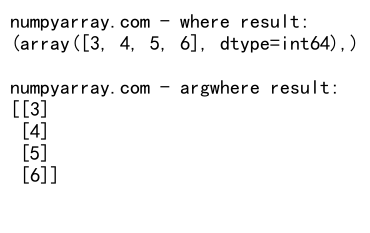
在这个例子中,我们可以看到where和argwhere函数都可以与logical_and函数配合使用,但它们的返回结果格式不同。
4. 实际应用示例
4.1 图像处理
在图像处理中,where和argwhere函数都可以用于查找特定像素。例如,我们可以使用这些函数来查找图像中的亮点:
import numpy as np
# 创建一个模拟图像的2D数组
image = np.random.randint(0, 256, size=(10, 10))
# 使用where函数找出亮点(像素值大于200)
bright_pixels_where = np.where(image > 200)
# 使用argwhere函数找出亮点
bright_pixels_argwhere = np.argwhere(image > 200)
print("numpyarray.com - Bright pixels (where):")
print(bright_pixels_where)
print("\nnumpyarray.com - Bright pixels (argwhere):")
print(bright_pixels_argwhere)
Output:
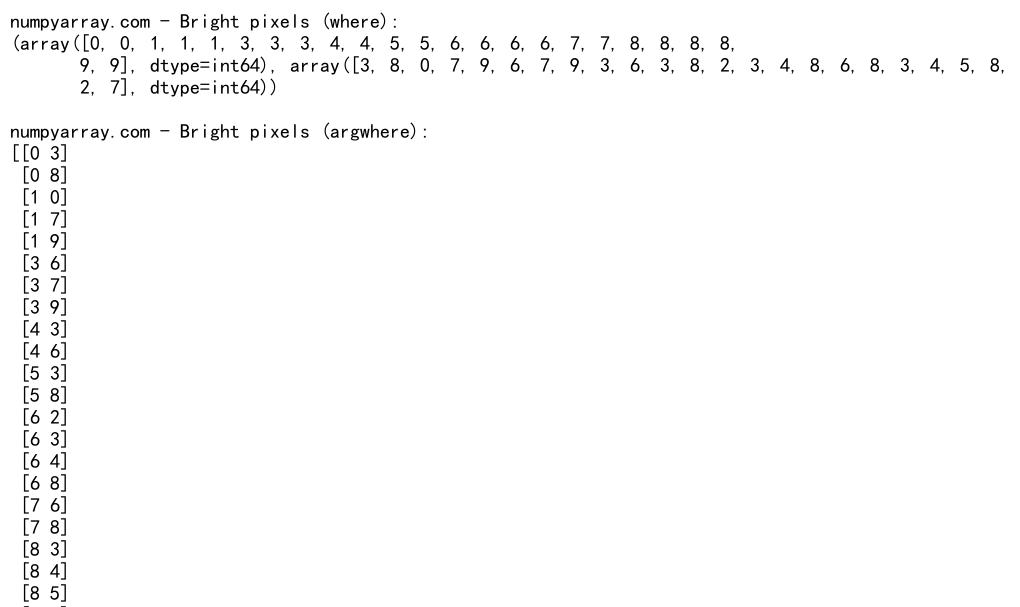
在这个例子中,我们创建了一个10×10的随机图像,然后使用where和argwhere函数找出像素值大于200的亮点。
4.2 数据清洗
在数据清洗过程中,where函数特别有用,因为它可以根据条件替换值:
import numpy as np
# 创建一个包含异常值的数组
data = np.array([1, 2, 3, 1000, 5, 6, 7, 8, 9, 10])
# 使用where函数将异常值替换为平均值
cleaned_data = np.where(data > 100, np.mean(data), data)
print("numpyarray.com - Original data:")
print(data)
print("\nnumpyarray.com - Cleaned data:")
print(cleaned_data)
Output:

在这个例子中,我们有一个包含异常值的数组。我们使用where函数将大于100的值(异常值)替换为数组的平均值,从而清洗数据。
4.3 金融数据分析
在金融数据分析中,argwhere函数可以用来找出股票价格突破某个阈值的日期:
import numpy as np
# 创建一个模拟股票价格的数组
stock_prices = np.array([100, 102, 98, 103, 105, 107, 106, 110, 112, 115])
# 使用argwhere函数找出股票价格突破110的日期
breakthrough_days = np.argwhere(stock_prices > 110)
print("numpyarray.com - Days when stock price broke through 110:")
print(breakthrough_days)
Output:

在这个例子中,我们使用argwhere函数找出股票价格突破110的日期(索引)。这种方法可以帮助分析师快速识别重要的价格变动。
4.4 科学计算
在科学计算中,where和argwhere函数都可以用于查找满足特定条件的数据点。例如,在物理实验中查找临界点:
import numpy as np
# 创建一个模拟实验数据的数组
temperature = np.linspace(0, 100, 101)
pressure = np.sin(temperature * np.pi / 50) * 10 + 100
# 使用where函数找出压力大于105的温度点
critical_points_where = np.where(pressure > 105)
# 使用argwhere函数找出压力大于105的温度点
critical_points_argwhere = np.argwhere(pressure > 105)
print("numpyarray.com - Critical points (where):")
print(temperature[critical_points_where])
print("\nnumpyarray.com - Critical points (argwhere):")
print(temperature[critical_points_argwhere.flatten()])
Output:

在这个例子中,我们模拟了一个温度和压力的关系实验。我们使用where和argwhere函数找出压力超过105的温度点,这些可能是实验中的临界点。
5. 高级技巧和注意事项
5.1 处理NaN值
在处理实际数据时,我们经常会遇到NaN(Not a Number)值。where和argwhere函数在处理NaN值时有一些特殊的行为:
import numpy as np
# 创建一个包含NaN值的数组
arr = np.array([1, 2, np.nan, 4, 5])
# 使用where函数找出非NaN值
non_nan_where = np.where(~np.isnan(arr))
# 使用argwhere函数找出非NaN值
non_nan_argwhere = np.argwhere(~np.isnan(arr))
print("numpyarray.com - Non-NaN indices (where):")
print(non_nan_where)
print("\nnumpyarray.com - Non-NaN indices (argwhere):")
print(non_nan_argwhere)
Output:
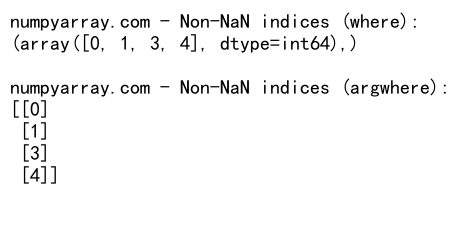
在这个例子中,我们使用~np.isnan(arr)来创建一个布尔掩码,标识非NaN值。然后我们使用where和argwhere函数找出这些非NaN值的索引。
5.2 处理复杂条件
有时我们需要处理更复杂的条件。where和argwhere函数都可以与NumPy的逻辑函数结合使用:
import numpy as np
# 创建一个示例数组
arr = np.array([1, 2, 3, 4, 5, 6, 7, 8, 9, 10])
# 使用where函数找出能被2整除但不能被3整除的元素
complex_condition_where = np.where((arr % 2 == 0) & (arr % 3 != 0))
# 使用argwhere函数找出能被2整除但不能被3整除的元素
complex_condition_argwhere = np.argwhere((arr % 2 == 0) & (arr % 3 != 0))
print("numpyarray.com - Complex condition result (where):")
print(complex_condition_where)
print("\nnumpyarray.com - Complex condition result (argwhere):")
print(complex_condition_argwhere)
Output:
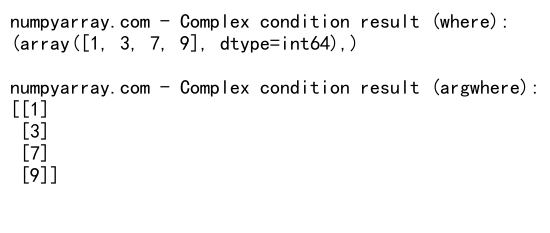
在这个例子中,我们使用复合条件来找出能被2整除但不能被3整除的元素。这展示了where和argwhere函数在处理复杂逻辑时的灵活性。
5.3 性能优化
当处理大型数组时,性能可能成为一个问题。在这种情况下,where函数通常比argwhere函数更快,因为它不需要构建完整的坐标数组。如果你只需要索引而不是完整的坐标,使用where函数可能是更好的选择。
5.4 内存使用
在处理非常大的数组时,argwhere函数可能会消耗大量内存,因为它需要为每个满足条件的元素创建一个完整的坐标。在这种情况下,使用where函数可能更为合适,因为它只返回索引。
5.5 与其他NumPy函数的结合
where和argwhere函数可以与其他NumPy函数结合使用,创造出强大的数据处理工具。例如,我们可以结合where函数和np.sum函数来计算满足特定条件的元素的和:
import numpy as np
# 创建一个示例数组
arr = np.array([1, 2, 3, 4, 5, 6, 7, 8, 9, 10])
# 计算大于5的元素的和
sum_greater_than_five = np.sum(np.where(arr > 5, arr, 0))
print("numpyarray.com - Sum of elements greater than 5:")
print(sum_greater_than_five)
Output:

在这个例子中,我们使用where函数创建一个新数组,其中大于5的元素保持原值,其他元素变为0。然后我们使用np.sum函数计算这个新数组的和,得到大于5的元素的总和。
6. 总结
NumPy的where和argwhere函数都是强大的工具,用于在数组中查找满足特定条件的元素。它们的主要区别在于返回值的格式和使用场景:
where函数返回一个元组,包含满足条件的元素的索引。它还可以根据条件选择不同的值。argwhere函数返回一个二维数组,其中每一行表示一个满足条件的元素的完整坐标。
在选择使用哪个函数时,需要考虑以下因素:
- 如果你需要分别获取每个维度的索引,或者需要根据条件选择不同的值,使用
where函数。 - 如果你需要获取完整的坐标,尤其是在处理高维数组时,使用
argwhere函数。 - 在处理大型数组时,
where函数通常比argwhere函数更快,因为它不需要构建完整的坐标数组。
无论选择哪个函数,它们都是数据分析、图像处理、科学计算等领域中不可或缺的工具。通过灵活运用这两个函数,我们可以更高效地处理和分析复杂的数据结构。
在实际应用中,建议根据具体需求和数据特性来选择合适的函数。同时,也要注意处理边界情况,如NaN值或特殊的数据分布。通过深入理解和熟练运用这两个函数,我们可以大大提高数据处理和分析的效率和准确性。
 极客笔记
极客笔记